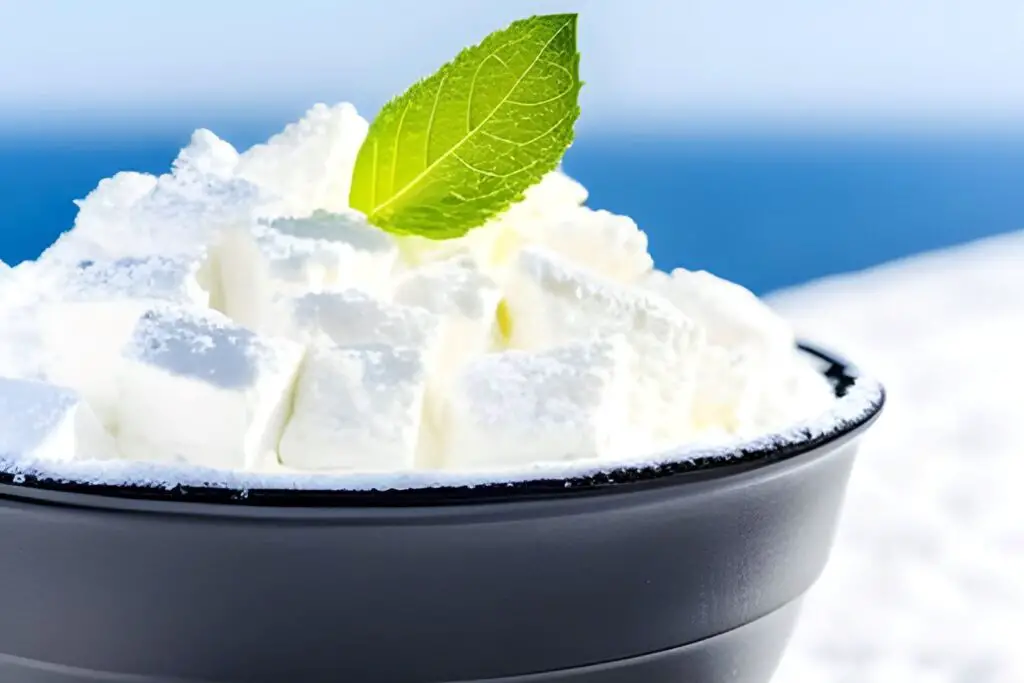
Cream cheese is a soft and creamy dairy product made from cow’s milk. It has a mild, slightly tangy flavor and a smooth texture. It is commonly used as a spread for bagels and sandwiches, as well as an ingredient in recipes like cheesecakes and dips. Whether you have leftover cream cheese or want to stock up during a sale, freezing it can be a convenient way to preserve its freshness and extend its shelf life. Freezing cream cheese allows you to have it readily available for future recipes without worrying about spoilage. In this article, we will discuss the process of freezing cream cheese and provide helpful tips to ensure its quality remains intact after thawing.
Here are the steps to freeze cream cheese:
Step 1: Prepare the cream cheese
Before freezing cream cheese, it’s crucial to ensure that it is fresh and in optimal condition. Start by checking the expiration date printed on the packaging. Using cream cheese that is close to or past its expiration date may result in compromised taste and texture.
Inspect the cream cheese for any signs of spoilage, such as mold growth or an unpleasant odor. If you notice any such indications, it’s best to discard the cream cheese instead of freezing it, as freezing will not revive the quality of spoiled cream cheese.
Additionally, if the cream cheese has already been opened and has been exposed to air, it is more susceptible to bacterial growth and loss of quality. In such cases, it is recommended to freeze the cream cheese as soon as possible to preserve its freshness.
By ensuring that the cream cheese is in its best condition before freezing, you can maintain its quality throughout the freezing and thawing process, resulting in a better culinary experience when you use it later.
Step 2: Portion the cream cheese
To facilitate easy thawing and convenient usage, it is recommended to divide the cream cheese into portions before freezing. This step allows you to take out only the amount you need without having to thaw the entire block.
Consider your usage preferences and the typical quantities you require for recipes or individual servings. You can choose to freeze the cream cheese as a whole block if you often use it in larger quantities. Alternatively, dividing it into smaller portions is ideal if you frequently use smaller amounts or prefer pre-measured portions for specific recipes.
When dividing the cream cheese, it is important to use freezer-safe containers or freezer bags. These containers are specifically designed to withstand low temperatures and prevent freezer burn, which can adversely affect the texture and quality of the cream cheese.
Ensure that each portion is appropriately sealed and labeled with the date of freezing. This will help you keep track of the cream cheese’s storage time and maintain proper rotation, using the oldest portions first.
Step 3: Wrap the cream cheese tightly
To protect the cream cheese from freezer burn and maintain its texture, it is essential to wrap each portion tightly in plastic wrap. Freezer burn occurs when moisture from the cream cheese evaporates, leaving it dehydrated and affecting its quality.
By tightly wrapping the cream cheese, you create a barrier that helps retain moisture and prevents the entry of air, which can lead to freezer burn. Make sure to cover the entire surface of the cream cheese and eliminate any exposed areas.
Additionally, proper wrapping prevents the cream cheese from absorbing unwanted odors from other foods in the freezer. Cream cheese can easily pick up flavors from strongly scented items nearby, affecting its taste when thawed. Wrapping it tightly in plastic wrap helps preserve its original flavor.
When wrapping the cream cheese, ensure that the plastic wrap adheres closely to the surface, leaving no gaps or openings. This will provide an effective seal and help maintain the cream cheese’s quality during freezing.
Can I freeze cream cheese in a freezer-safe bag without wrapping?
It is generally not recommended to freeze cream cheese in a freezer-safe bag without any additional wrapping. Cream cheese is prone to picking up odors and flavors from the freezer environment, which can affect its taste. Wrapping cream cheese in plastic wrap before placing it in a freezer bag provides an extra layer of protection against freezer burn and helps maintain its texture and quality during freezing and thawing.
Step 4: Place the wrapped cream cheese in a freezer-safe bag
After tightly wrapping each portion of cream cheese, the next step is to place them in a freezer-safe bag. Using a freezer-safe bag provides an additional layer of protection against freezer burn and helps maintain the cream cheese’s quality.
When placing the wrapped cream cheese portions in the bag, it is important to squeeze out any excess air before sealing it tightly. The presence of air inside the bag can contribute to the formation of ice crystals, which can negatively affect the texture of the cream cheese when thawed.
By removing the air from the bag, you create a vacuum-like environment that minimizes the risk of freezer burn and helps preserve the cream cheese’s texture. It also reduces the likelihood of ice crystals forming, which can cause a grainy or watery consistency in the thawed cream cheese.
Ensure that the bag is sealed securely to prevent any air or moisture from entering. A tightly sealed bag provides an optimal environment for freezing, maintaining the cream cheese’s quality and preventing unwanted changes in taste and texture.
Can I freeze the cream cheese in the original container?
Freezing cream cheese directly in its original container is not recommended. The original packaging is not designed to withstand freezing temperatures and may not provide sufficient protection against freezer burn. It is best to transfer the cream cheese to a freezer-safe container or wrap it tightly in plastic wrap and place it in a freezer bag to maintain its quality during freezing. Properly stored cream cheese will have a longer shelf life and better texture when thawed.
Step 5: Label and date the package
Labeling and dating the package is an important step when freezing cream cheese. It allows you to keep track of the freezing date and ensures proper rotation, so you can use the cream cheese in the order it was frozen.
By labeling the freezer bag with the current date, you create a reference point for the cream cheese’s storage time. This is particularly useful when you plan to store the cream cheese for an extended period, as it helps you keep track of how long each package has been frozen.
Labeling also enables you to identify the oldest packages of cream cheese, ensuring that you use them first. This practice helps avoid wastage by using the cream cheese before it exceeds its recommended storage time. Using the cream cheese in the order it was frozen maintains its optimal quality and flavor.
When labeling the package, it is helpful to include the freezing date and any specific details you want to note, such as portion sizes or flavor variations. This additional information can assist in planning and selecting the appropriate package for future use.
Step 6: Store in the freezer
Once you have properly labeled and sealed the freezer bag containing the cream cheese portions, it’s time to store them in the freezer. Proper storage in the freezer is crucial for maintaining the quality and freshness of the cream cheese.
When placing the cream cheese in the freezer, choose a section where the temperature remains consistently cold, such as the back or middle shelves. These areas tend to have a more stable temperature, which helps preserve the cream cheese’s texture and taste.
It is important to avoid placing the cream cheese near the freezer door. The door is frequently opened and closed, leading to temperature fluctuations and exposure to warmer air from the surrounding environment. These temperature changes can negatively affect the cream cheese’s quality, leading to potential texture issues and shorter shelf life.
Ensure that the labeled and sealed freezer bag is stored in a way that prevents it from being crushed or damaged by other items in the freezer. Placing it in a designated spot where it is protected from potential pressure or impact helps maintain the integrity of the cream cheese packaging.
Other related questions
How long can cream cheese last in the freezer?
Cream cheese can last in the freezer for up to two to three months without significant loss of quality. It is important to ensure that the cream cheese is tightly wrapped and properly stored to minimize the risk of freezer burn. However, for the best taste and texture, it is recommended to consume the frozen cream cheese within one to two months.
How do I defrost cream cheese?
When you are ready to use the frozen cream cheese, follow these steps for thawing:
- Transfer to the refrigerator
Remove the desired portion of frozen cream cheese from the freezer and transfer it to the refrigerator. Allow it to thaw slowly in the refrigerator, as this helps maintain its texture and prevents rapid bacterial growth.
- Thaw overnight
Depending on the portion size and temperature of your refrigerator, the cream cheese will typically thaw overnight. For larger portions, it may take up to 24 hours to fully thaw. It is important not to rush the thawing process by using alternative methods, such as a microwave, as they can compromise the texture and result in a watery consistency.
How do I know if the cream cheese has gone bad after being frozen?
After being frozen, if cream cheese develops an off odor, unusual texture, or shows signs of mold growth, it may indicate spoilage. Discard cream cheese if it has a rancid or sour smell, becomes watery or grainy, or exhibits visible mold. Proper storage and adherence to recommended freezing times are crucial to maintaining the quality of cream cheese and preventing spoilage.
Can I refreeze the cream cheese?
It is generally not recommended to refreeze cream cheese after it has been thawed. Once the cream cheese is thawed, its texture and quality can be adversely affected by the freezing and thawing process. Additionally, the growth of bacteria may occur if the cream cheese is repeatedly frozen and thawed. It is best to use thawed cream cheese promptly and avoid refreezing it for optimal taste and safety.
Can I freeze cream cheese that has been opened and partially used?
Yes, it is possible to freeze cream cheese that has been opened and partially used. However, it is essential to note that freezing can alter the texture and consistency of cream cheese. Before freezing, ensure that the remaining cream cheese is tightly sealed in an airtight container or freezer bag to minimize the risk of freezer burn and maintain its quality. Thawed cream cheese may have a slightly different texture, so it is best used in recipes that require blending or mixing rather than as a spread.
Can I freeze flavored or herb-infused cream cheese?
Yes, flavored or herb-infused cream cheese can be frozen, but it’s important to consider the specific flavorings or herbs used. Some spices and flavorings may lose their potency or change in flavor after freezing. It is recommended to freeze flavored or herb-infused cream cheese in small portions, properly wrapped and sealed, to maintain its quality. Thawed cream cheese may have a slightly altered taste compared to fresh, so it is advisable to test the flavor before using it in recipes.
Can I use frozen cream cheese in recipes that call for fresh cream cheese?
Yes, frozen cream cheese can be used in recipes that call for fresh cream cheese, but there are some considerations to keep in mind. Thawed cream cheese may have a slightly different texture and consistency compared to fresh cream cheese, so it may not be suitable for certain applications that require a specific texture, like spreading. However, it can be successfully used in recipes that involve blending or cooking, such as cheesecakes, dips, or baked goods, where the texture changes are less noticeable.








